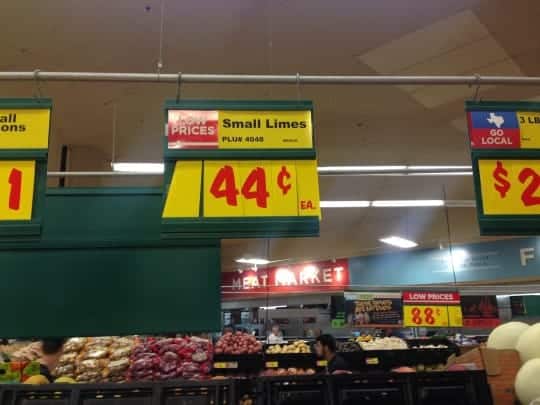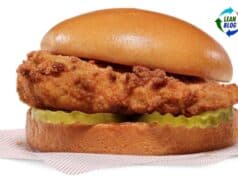Limes are a very big deal here in San Antonio, between the cuisine and, of course, margaritas. Hint: life is too short to drink “margaritas” with some corn-syrupy pre-made mix. All you need is tequila, lime juice, and agave nectar. Maybe Cointreau or good triple sec.
But, the price of limes has been sky high recently. Since today is Cinco de Mayo, let's take a look at this from a Lean perspective and how this should be handled by bars and restaurants.
This was in the news first here in San Antonio: Margaritas in danger as lime prices at all-time high.
Limes have often been priced, in grocery stores here, as 6 for $1.00. Limes are normally pretty cheap.
Recently, it's been more like 3 limes for a buck. Yesterday, they were 44 cents each (and small limes, indeed – they are tiny compared to normal).

As it said in the local paper:
Wholesalers and local restaurant managers say prices for the small citrus fruit has rocketed to an all-time high during the last month, mostly stemming from various climate factors. Some restaurants in the Alamo City say they've been forced to make adjustments, including garnishing margaritas, water and tea with lemons rather than limes or only offering the sour fruit upon request.
When an ingredient gets more expensive, I can understand trying to avoid them when they're not necessary. Does the customer really care if there is a wedge of lime in the water or iced tea? Since “value is defined by the customer,” as we say in Lean, you'd have to ask the customer. Limes “on request” for certain items makes sense, as they would be wasted if the customer takes the lime out of the water or doesn't care that it's there.
But, excluding them from a margarita… maybe you're just being cheap, or penny wise and pound foolish. Reducing waste is good — slashing the “value” delivered to the paying customer is bad.
Yes, wholesale prices are up four or five times the old prices. But, even if a lime costs 44 cents (and I'm guessing the wholesale price is lower), you can probably get six or eight wedges from a lime. That's 6 or 7 cents per customer. I hope that's not the difference between profit and loss for your bar or restaurant.
One restaurant started using lemons as a replacement for limes on their salsa bar. That might be a better substitute than would be for a margarita (it's an altogether different drink if you use lemons… and nobody makes that, probably for good reason). One restaurant on the famed Riverwalk is garnishing margaritas with a lemon wedge. That might fool a tourist, but I'd send that drink back.
Using lime concentrate, as one bar does, instead of fresh lime juice might be cheaper, but you're also hurting quality.
Skimping on a squeeze of lime juice in your guacamole (half a lime, 22 cents) might also diminish quality.
Why are the prices high? Supply and demand. Drought in Mexico has led to smaller crops (and, apparently, smaller limes)
Basic Economics & Lean Economics
When supplies are tight, prices go up. The suppliers are charging more to the restaurants. The bars and restaurants can either try to pass the higher price onto their customers… but that might hurt their own sales. Customers might order different drinks (which might not be bad for the bar if the price and margin is about the same).
Or, the bars and restaurants might find ways of reducing waste (and reducing other costs) to make up for the higher cost of limes. A business can't automatically pass along cost increases as price increases to customers without any harm.
Lean and the Toyota Production System literature teaches us that:
- Prices are set by the market
- Profit = Price we can charge – Our costs
- To maintain profits, we're probably better off trying to maintain costs, rather than boosting prices
The old “cost plus” model rarely works anymore. The old mindset was that our business is “entitled” to a certain profit margin, so we take our costs and add a percentage to set our price. If costs go up, we claim we're “forced” to increase prices… but customers might stay away or do other things that hurt our business in the long term.
I cringe when I hear companies complaining about their costs – trying to stick it to the customers instead of being creative and taking cost out in other ways. I cringe, especially, when my publisher increases prices for books annually. Are these really higher prices that the market will bear or are they raising prices “because they have to” or “because costs have gone up?” The list price of Lean Hospitals has gone up from about $42 to about $56 in five years (about 33%!!). Thank goodness for Amazon discounts.
Instead of being cheap and cutting quality, maybe restaurants can reduce waste. One bar owner talked about cutting five buckets worth of limes. I understand the need to do prep work in advance, but I wonder how many limes get cut and wasted? Are there other ways the restaurant or bar can reduce waste to save money in ways that don't affect customers. Can we prevent food waste? Energy waste? Can we change our staffing schedules so we're not overstaffed during slow times? What else can we do to reduce waste instead of reducing value?
This was also discussed recently in the Wall St. Journal: Lime Shortage Drives Up Prices at Bars and Restaurants in U.S.
A California bar was creative and asked customers to bring limes in from home:
“Bring us a bag full of limes and get a crafted cocktail for just 25 cents,” Mr. Dennis posted on Facebook and Twitter. He put up a sign in the restaurant: “WE WANT YOUR LIMES.”
That's more creative than just jacking up prices or leaving limes out of the drinks.
So What Can You Do?
You might have to pay more for your margarita – or you'll order something else.
But, what does your organization do when faced with a cost increase for one of your main components – whether it's labor costs, supply costs, equipment costs, gas, rent, etc.? What's the Lean thing to do?
Please scroll down (or click) to post a comment. Connect with me on LinkedIn.
Let’s build a culture of continuous improvement and psychological safety—together. If you're a leader aiming for lasting change (not just more projects), I help organizations:
- Engage people at all levels in sustainable improvement
- Shift from fear of mistakes to learning from them
- Apply Lean thinking in practical, people-centered ways
Interested in coaching or a keynote talk? Let’s talk.
Join me for a Lean Healthcare Accelerator Trip to Japan! Learn More










Comment from my dad on Facebook:
If the cost of the labor time is less than the value of the lime juice they get out, then that’s probably a good idea to not waste juice… to get every last drop out.
There are ways to get more juice out of each lime, including rolling them a bit before squeezing or even giving a short microwave blast to them.
More on getting more juice out of limes… I’ll call these methods good changes to standardized work… not just “cost cutting.”
LINK
Data must be taken in context of the value stream. Sure a price increase on a key input might raise a giant red flag over that variable, but that doesn’t mean the cost savings have to come out of that input. In fact, it will likely be easier to look elsewhere to bring the profit equation back in line. As if the company uses cost accounting, material costs have been under a magnifying glass for some time.
Right, we can find other ways to reduce costs. I doubt the bars and restaurants are using cost accounting other than maybe tracking high level food and alcohol revenue, cost, and profits in those two categories. Breaking out alcohol is required for tax purposes.
Fun post on Cinco de Mayo! Rubio’s, a great little chain of fast foodish but healthy Mexican food in San Diego has had no limes (my fav citrus fruit) for the month. They have signs that lament the shortage and high costs and apologize for the missing condiment. Yelp has new reviews the mention the missing limes.
Did you hear about the lime truck hijacking and how the lime shortage is linked to the drug trade in Mexico? http://www.npr.org/2014/03/20/291896473/soaring-lime-prices-put-squeeze-on-restaurants-food-lovers
Crazy shit.
I did hear something about Mexican cartel involvement.
If Rubio’s can’t get limes, I don’t think they’re trying hard enough. If they are being cheap… I just don’t understand how they could skimp on an ingredient that’s so important for, say, fish tacos.
If a pizzeria was facing an increase in cheese costs… they might skimp a bit on the cheese (which is fine, since most American-ized pizza has way too much cheese), but then they are messing with the core of their product… bad quality leads to bad reviews, which leads to less business.
It’s easy to see how a company can cost-cut themselves into oblivion.
An illustration of the lime shortage… I was in a Whole Fooda in Southern California and there were NO limes in the store to be bought at any price.
Whole Foods. There’s your problem. I just picked up a 5 pound bag at Costco. Margarita weekend ahead.